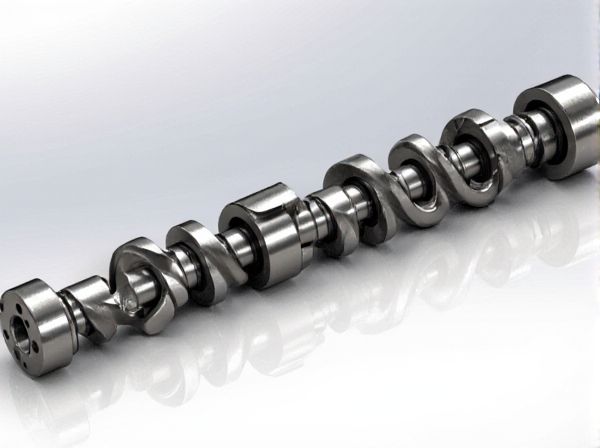
Photo illustration: Short Stroke vs Long Stroke Crankshaft
Short stroke crankshafts feature a smaller piston travel distance, resulting in higher engine RPM and quicker acceleration, ideal for sportier performance. Long stroke crankshafts offer greater torque and fuel efficiency by increasing piston travel, making them suitable for heavy-duty and fuel-conscious applications. Your choice depends on whether you prioritize high-revving power or low-end torque.
Table of Comparison
| Feature | Short Stroke Crankshaft | Long Stroke Crankshaft |
|---|---|---|
| Stroke Length | Shorter stroke, typically less than bore diameter | Longer stroke, usually greater than bore diameter |
| Engine RPM | Higher maximum RPM capability | Lower maximum RPM due to longer stroke |
| Torque Output | Lower torque at low RPM | Higher torque at low RPM |
| Power Delivery | High power at high RPM ranges | Strong power at low to mid RPM ranges |
| Engine Size | Compact design, typically lighter | Larger size due to longer piston travel |
| Fuel Efficiency | Usually less fuel-efficient at low RPM | Better fuel efficiency at low RPM |
| Applications | Sports cars, racing engines | Trucks, heavy-duty and economy vehicles |
Introduction to Crankshaft Stroke
Crankshaft stroke defines the distance the piston travels within the engine cylinder, directly influencing engine displacement and performance characteristics. Short stroke crankshafts feature a smaller piston travel distance, promoting higher engine speeds and improved responsiveness, making them ideal for high-revving applications. Long stroke crankshafts extend the piston travel, increasing torque output and efficiency at lower RPMs, which benefits engines designed for durability and fuel economy.
Defining Short Stroke Crankshafts
Short stroke crankshafts feature a smaller crank radius, leading to a reduced piston travel distance within the cylinder and enabling higher engine revolutions per minute (RPM). This design increases the engine's ability to rev quickly and improves top-end performance, commonly seen in high-performance and racing engines. Compared to long stroke crankshafts, short stroke variants typically generate less torque but excel in power output at elevated RPM ranges.
Understanding Long Stroke Crankshafts
Long stroke crankshafts have a greater throw, resulting in increased piston travel that enhances torque at lower RPMs, ideal for applications requiring strong low-end power. By extending the stroke length relative to the bore diameter, these crankshafts improve engine efficiency through better combustion characteristics and increased leverage on the crank arms. Commonly found in diesel engines and performance setups prioritizing durability and torque, long stroke crankshafts deliver a responsive driving experience with improved fuel economy under typical driving conditions.
Key Performance Differences
Short stroke crankshafts feature a smaller piston stroke length, allowing engines to rev higher and produce more peak power due to reduced piston speed and inertia. Long stroke crankshafts deliver greater torque at lower RPMs by increasing piston travel and leverage on the crank, optimizing engine efficiency in low-end power applications. The key performance differences center on rev range and torque output, with short stroke favoring high-rev horsepower and long stroke enhancing low-end torque and fuel economy.
Torque and Power Delivery Comparison
Short stroke crankshafts typically deliver higher engine revs with quicker throttle response, optimizing peak power output due to reduced piston travel and lower inertia. Long stroke crankshafts enhance torque production at lower RPMs by increasing piston leverage and combustion efficiency, resulting in stronger low-end power delivery. The choice between short and long stroke depends on balancing high-RPM horsepower versus consistent low-end torque for specific performance goals.
Impact on Engine RPM and Redline
Short stroke crankshafts increase engine RPM capacity by reducing piston travel distance, enabling higher redline limits and improved high-rev performance in sports and racing engines. Long stroke crankshafts produce greater torque at lower RPMs due to increased piston leverage but often limit maximum engine speed and redline to preserve mechanical durability. The stroke-to-bore ratio fundamentally influences engine characteristics, where short stroke designs favor speed and long stroke designs favor torque output.
Fuel Efficiency Considerations
Short stroke crankshafts typically enhance fuel efficiency by reducing piston travel, which lowers frictional losses and improves combustion efficiency. Long stroke crankshafts increase torque at lower RPMs but often result in higher fuel consumption due to increased pumping losses and reduced thermal efficiency. Engine designs prioritizing fuel economy generally favor short stroke configurations for their ability to optimize air-fuel mixture combustion and reduce energy waste.
Applications in Motorsports and Daily Driving
Short stroke crankshafts, characterized by a smaller crank radius, enable higher engine RPMs and quicker acceleration, making them ideal for motorsports applications such as Formula 1 and rally racing where rapid power delivery is crucial. Long stroke crankshafts provide increased torque and improved fuel efficiency, benefiting daily driving scenarios like commuter vehicles and light trucks that demand smooth power output and better drivability. Performance tuning often balances stroke length to optimize engine characteristics for specific use cases, blending high-revving capability with durability and efficiency.
Maintenance and Durability Factors
Short stroke crankshafts typically offer higher engine speeds and reduced wear on internal components due to lower piston travel, enhancing maintenance intervals and overall durability. Long stroke crankshafts generate higher torque at lower RPMs but endure increased mechanical stress and friction, potentially leading to more frequent maintenance and faster component wear. Selecting between the two depends on balancing durability demands with performance goals and maintenance capabilities.
Choosing the Right Crankshaft for Your Build
Choosing the right crankshaft depends on your engine's performance goals and build type. Short stroke crankshafts offer higher RPM potential and quicker throttle response, ideal for high-revving engines and racing applications. Long stroke crankshafts provide increased torque and low-end power, making them suitable for street builds and heavy-duty engines.
 caratoz.com
caratoz.com